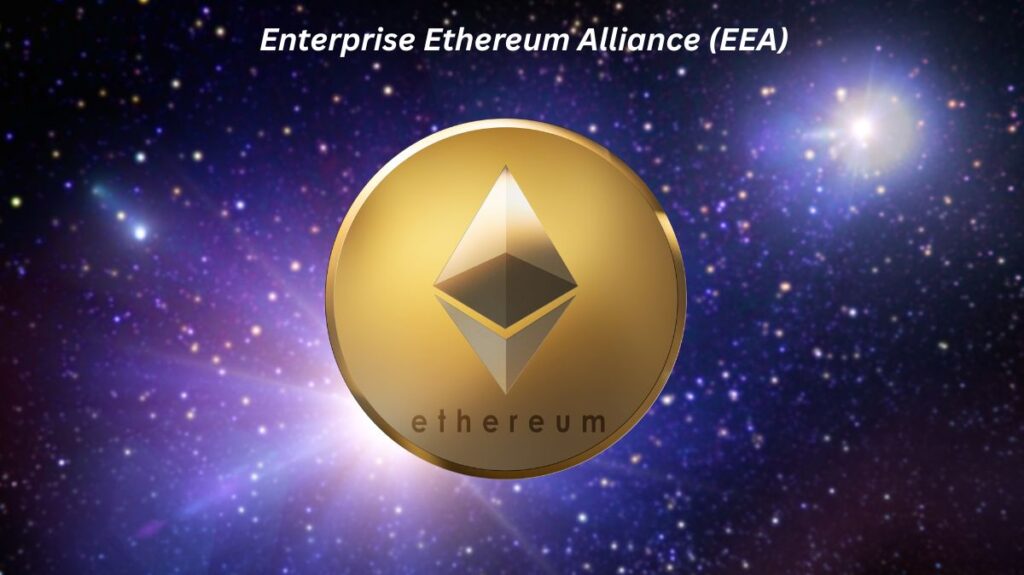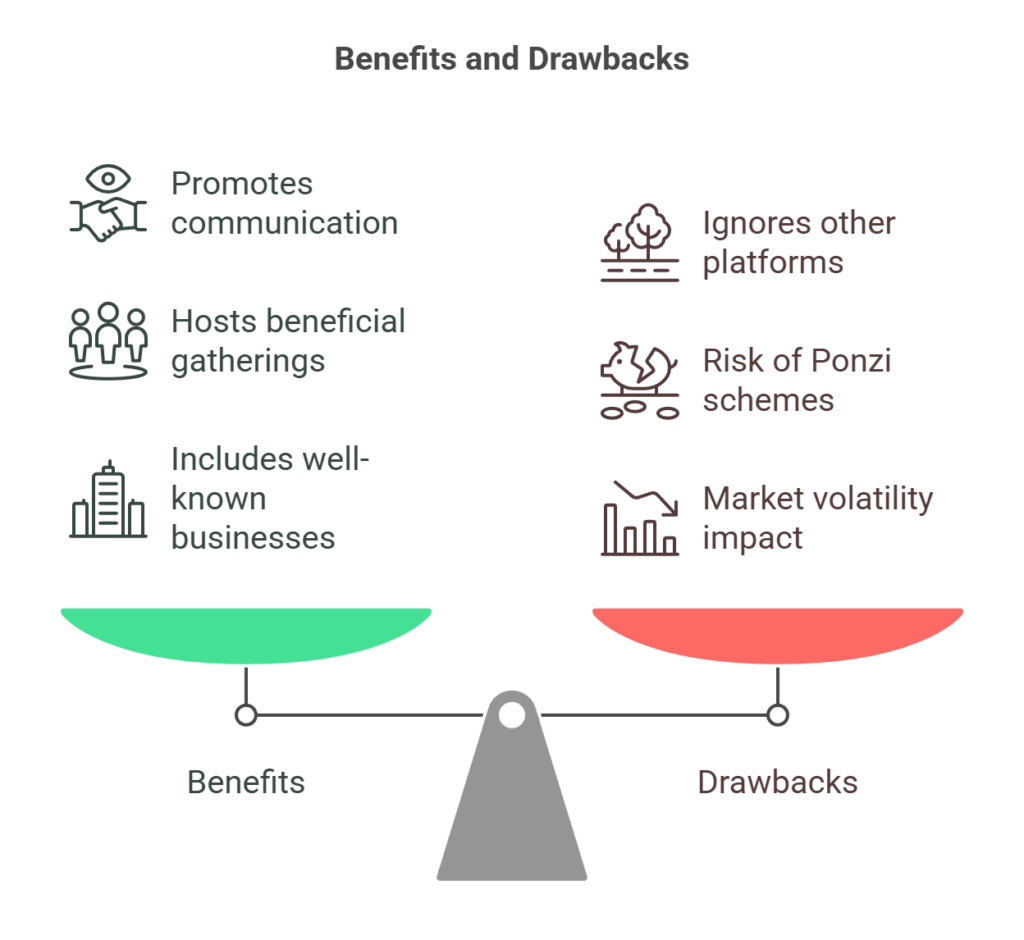EEA blockchain

The global, member-led Enterprise Ethereum Alliance (EEA) promotes enterprise Ethereum blockchain adoption. Since its February 2017 inception, it has expanded from 30 members to the largest open-source blockchain project worldwide by July 2017.
The main goal of the EEA is to hasten Enterprise Ethereum adoption by providing an open, standards-based architecture and specification. It seeks to close the gap between cutting-edge blockchain technology and useful business applications.
Key objectives include:
- Making Ethereum blockchain technology easier for businesses to adopt.
- Ethereum-based solutions need technical standards and frameworks for interoperability, security, and scalability.
- Fostering business-related Ethereum experiments through research and innovation.
- Ensuring Practical Implementation: To illustrate Ethereum’s efficacy, case studies, real-world examples, and best practices are provided.
- Ensuring that Ethereum-based systems can communicate with other blockchain networks and technologies in a seamless manner is known as “promoting interoperability.”
- Ethereum is being developed by the EEA to become an enterprise-grade system that can manage corporate applications and large-volume transactions.
How the EEA Works
The EEA is an organisation run by its members. Four primary tasks serve as its compass:
- Recognising the needs of the enterprise.
- Constructing standard standards that take these needs into account.
- Developing in tandem with and incorporating the open Ethereum blockchain.
- Establishing certification programs to achieve worldwide interoperability.
The alliance seeks to develop, advance, and support best practices, standards, and a reference architecture for Ethereum blockchain technology that can manage practical applications. To showcase advancements in the enterprise blockchain field, it frequently hosts events and carries out research.
Participation
Start-ups, Fortune 500 firms, technology vendors, academia, and Ethereum subject matter experts are all represented in the EEA. Accenture, BlockApps, ConsenSys, Ethereum Foundation, EY, J.P. Morgan, Microsoft, and Santander are among the notable board members. There are more than 100 organisational and associate members. Globally, members represent a wide range of industries, including banking, insurance, healthcare, energy, technology, marketing, and pharmaceuticals.
Membership types include:
- Corporate Members: financial institutions, tech firms, and big businesses.
- Startup Participants (innovators and blockchain startups).
- Academic and Research Establishments (research centres and universities).
- Non-profits and government organisations (public sector organisations).
- Industry Consortia (other collaborations within the industry).
- Participating organisations must apply, stating their interest and contribution. Along with local legislation, they must follow the EEA’s norms, intellectual property rights, confidentiality, and antitrust principles. The size and nature of the organisation dictate the annual dues.
Also Read About Drizzle Blockchain: Simplify DApp Front-end Development
Benefits of Membership
Businesses can use Ethereum technology in their operations by joining the EEA. Advantages consist of:
- Access to EEA technology frameworks, standards, and documentation.
- Networking with technology suppliers, industry leaders, and other stakeholders in the largest Ethereum ecosystem exposes you to over 20,000 Ethereum community members.
- Marketing options include speaking, branding, and event advertising.
- Involvement in working groups to vote on technological advancements and solve Ethereum’s problems.
- The ability to test on the EEA Testnet.
- To guarantee that solutions satisfy industry standards and interoperability requirements, the EEA provides certification.
- Building enterprise-level solutions and participating in best practices.
- Access to the 3,000+ contributors and 15+ user groups that make up the worldwide development community, which spans 25 sectors and six continents.
EEA Efforts and Features (Technical Aspects)
- An “Enterprise-grade” Ethereum that satisfies business requirements for privacy, performance, and permissioning is the focus of the EEA’s initiatives.
- Pilot Projects: Members have started and worked on pilot projects in fields such securities settlement, reference data, interbank payments, and supply chain provenance monitoring.
- The EEA offers webinars, DVDs, bulletins, and educational materials.
- The EEA produced open standards, “EEA Specifications,” to create enterprise-ready, interoperable blockchain systems. Enterprise Ethereum blockchains are client-compatible with the Enterprise Ethereum Blockchain Specification.
- The Enterprise Ethereum Blockchain requires smart contracts to be certified to meet EthTrust Security Level 1 and SHOULD be certified to meet EthTrust Security Level 3.
- Permissioning contracts for nodes and accounts MUST be certified as adhering to EthTrust Security Levels 2 and 3.
- Technical Architecture (EEA Stack): The Enterprise Ethereum Architecture Stack, which offers a guide for implementing Ethereum in businesses, is published by the EEA. Application, Tooling, Enterprise 3 P’s, Core Blockchain, and Network are its five layers.
- The three Ps of enterprise: privacy, performance, and permissioning:
- Enterprise Permissioning Ethereum uses permissioned blockchains, which limit which accounts may carry out particular tasks and which nodes can join. The genesis block’s smart contracts are used to manage this. Listing authorised accounts to communicate with the blockchain, controlling node-to-node connections, and differentiating permissions for smart contract creation and execution are all made possible by permissioning contracts.
- Privacy: To address privacy issues, the EEA uses strategies like anonymous participant support and private transactions. It also investigates cutting-edge cryptographic approaches like zero-knowledge proofs. Off-chain trustworthy computing is also supported for code execution privacy.
- EEA uses off-chain computing and on-chain (Layer 1 and Layer 2 scaling, such as sharding and state-channels) scaling mechanisms to optimise transaction performance.
- The standards require privileged keys to be stored in a Hardware Security Manager (HSM) and managed according to NIST best practices. Upgradeable contracts and the handling of sensitive data are also covered. A smart contract-based Organisation Registry is covered in an experimental part. Its goal is to use identification proofs such as Verifiable Presentations or X.509 Certificates to validate organisational ownership of Ethereum accounts and nodes on the blockchain.
- Consensus Algorithms: The QBFT consensus algorithm or the Clique Proof of Authority must be used on enterprise Ethereum blockchains.
- Smart Contract Size: The maximum size of a smart contract that can be implemented is specified by the maxCodeSize network configuration parameter.
Project Examples
Two primary project types are supported by the EEA:
Community Projects:
These are group-led, open-source initiatives to which anybody can contribute. Examples include an initiative to create standards for Layer 2 blockchain scalability solutions and the Baseline Protocol, a zero-knowledge enterprise framework for coordinating business activities with privacy.
Member Projects:
These are joint ventures amongst EEA members that are aided by working and interest groups. Working groups for digital identification and energy are two examples, with the goal of establishing Ethereum standards in respective sectors.
Benefits and Drawbacks

Benefits:
- Brings together various Ethereum-interested organisations, promoting communication and accelerating teamwork.
- Hosts beneficial gatherings for information exchange, education, and networking.
- Includes well-known businesses, giving the group legitimacy.
- Not limited to finance and technology, but any kind of organisation that satisfies the requirements is welcome.
Drawbacks:
- Ignores other blockchain platforms in favour of concentrating only on commercial Ethereum applications.
- Has come under fire for failing to properly screen members; one former member, Kuailian, turned out to be a Ponzi scam.
- The market’s natural volatility may hinder crypto groups like the EEA in downturn markets.
The EEA connects Ethereum innovation to corporate needs by providing the standards, frameworks, and community support needed to turn cutting-edge blockchain technology into secure, legal, and scalable commercial solutions.
